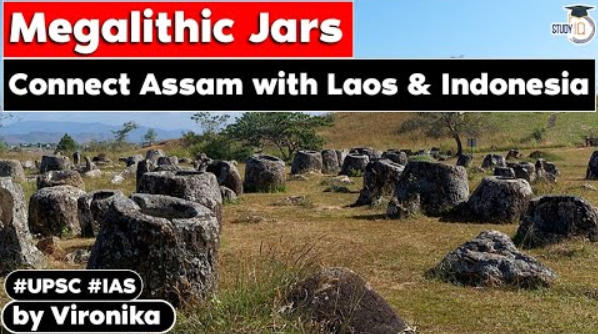Table of Contents
- How ancient megalithic jars connect Assam with Laos and Indonesia?

- The discovery of a number of megalithic stone jars in Assam’s Dima Hasao district has brought to focus possible links between India’s Northeast and Southeast Asia, dating back to the second millennium BC.

- According to a study in Asian Archaeology, the jars are a “unique archaeological phenomenon”.
- It calls for more research to understand the “likely cultural relationship” between Assam and Laos and Indonesia, the only two other sites where similar jars have been found.
What is Megalith?
- A megalith is a large stone that has been used to construct a structure or monument, either alone or together with other stones.
- In India, megaliths of all kinds are noted; these vary from Menhirs, Rock-cut burial, chamber tomb, dolmens, stone alignment, stone circles and anthropomorphic figures.
Megalithic Culture
- The burial sites are the sites with actual burial remains, such as dolmenoid cists (box-shaped stone burial chambers), cairn circles (stone circles with defined peripheries), and capstones (distinctive mushroom-shaped burial chambers found mainly in Kerala).
- Commemorative megaliths include memorial sites.
- In India, archaeologists trace the majority of the megaliths to the Iron Age (1500 BC to 500 BC), though some sites precede the Iron Age, extending up to 2000 BC.
- Megaliths are spread across the Indian subcontinent.
- The majority of megalithic sites are found in Peninsular India, concentrated in the states of Maharashtra (mainly in Vidarbha), Karnataka, Tamil Nadu, Kerala, Andhra Pradesh, and Telangana.
Back to the Megalithic Jars
- The jars of Assam were first sighted in 1929 by British civil servants James Philip Mills and John Henry Hutton.
- They recorded their presence in six sites in Dima Hasao: Derebore (now Hojai Dobongling), Kobak, Kartong, Molongpa (now Melangpeuram), Ndunglo and Bolasan (now Nuchubunglo).
- These discoveries were followed up only in 2014, when a collaborative effort by researchers from the North-Eastern Hill University (NEHU) and Nagaland University under the Archaeological Survey of India (Guwahati circle) was undertaken.
- More such sites were later discovered in 2016 and 2020.
- Researchers documented three distinct jar shapes (bulbous top with conical end; biconcial; cylindrical) on spurs, hill slopes and ridge lines.
- At one site, Nuchubunglo, as many as 546 jars were found.
- Most of the jars they found were in “poor condition” because of factors such as “weather condition, forest growth and burning owing to shifting cultivation and road cutting.”.
- Researchers documented three distinct jar shapes (bulbous top with conical end; biconcial; cylindrical) on spurs, hill slopes and ridge lines.
- At one site, Nuchubunglo, as many as 546 jars were found.
- Most of the jars they found were in “poor condition” because of factors such as “weather condition, forest growth and burning owing to shifting cultivation and road cutting.”.
Significance
- While the jars are yet to be scientifically dated, the researchers said links could be drawn with the stone jars found in Laos and Indonesia.
- There are typological and morphological similarities between the jars found at all three sites.
- “There is no reported parallel anywhere else in India, apart from the northeast – this points to the fact that once upon a time a group of people having similar kind of cultural practice occupied the same geography between Laos and Northeast India.”
Connection with funeral practices
- Dating done at the Laos site suggests that jars were positioned at the sites as early as the late second millennium BC. The other takeaway is the link to mortuary practices.
- The paper stated that in Laos, researchers had said there was a “strong association” between the stone jars and mortuary practices, with human skeletal remains found inside and buried around the jars.
- In Indonesia, the function of the jars remains unconfirmed, although some scholars suggest a similar mortuary role.


- It is suggested that the jars were associated with mortuary rituals.
- The two researchers referred to the “practices of ancestral bone repository of tribes like Mikir, Sakchips, Hangkals, Kuki, Khasi and Synteng and evidence of cremated bone fragments placed in one of the jars”, stated the paper.
- In the 1930s, anthropologist Ursula Graham Bower described these as “funerary urns”.
- The next phase would involve systematic excavation of material remains as well as scientific dating.
- The researchers suggested additional surveys are required across Assam, as well as in Meghalaya and Manipur, “to understand the extent of this culture”.

Question:
Which of the following are associated with the Megalithic culture of India?
- Iron tools and implements
- Horses
- Dolmens
Choose the correct answer:
- Only A and B
- Only B and C
- Only A and C
- All of these
Latest Burning Issues | Free PDF


























 WhatsApp
WhatsApp